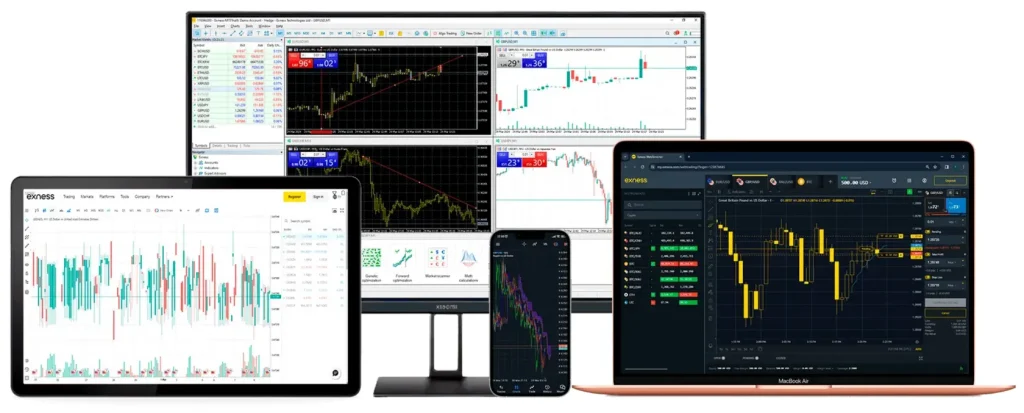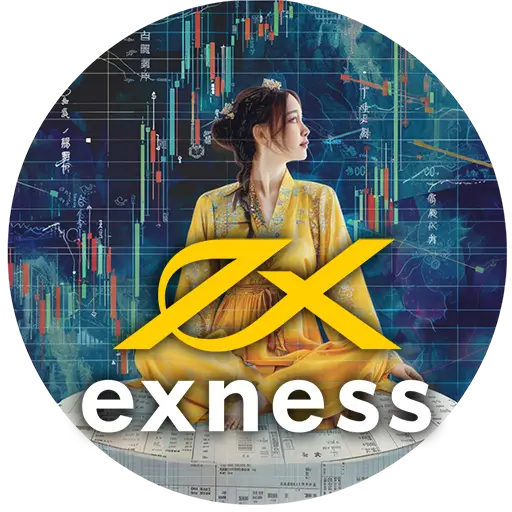Exness Trading Platform for African Markets
Home

Platform Architecture
Exness provides multiple trading interfaces adapted for African market conditions. The system architecture consists of front-end applications connecting to centralized trading servers. This structure delivers consistent trading conditions regardless of access method.
Connection protocols optimize data transmission for variable network quality found across African regions. The platform maintains functionality during intermittent connectivity through local data caching and transaction queuing. Server infrastructure operates across multiple geographic locations to reduce latency.
Backend systems process orders through a matching engine with execution speeds measured in milliseconds. The architecture separates order processing from market data distribution to maintain performance during high volume periods.

Available Trading Interfaces
MetaTrader 4 serves as a primary trading platform with widespread adoption across African markets. This interface offers stability on lower-specification computers common in developing markets. The platform requires minimal bandwidth while providing complete trading functionality.
MetaTrader 5 delivers an advanced alternative with expanded analytical capabilities. This version includes additional timeframes, technical indicators, and order types compared to MT4. The economic calendar integration helps traders monitor market-moving events directly within the platform.
Web Terminal provides browser-based trading without requiring software installation. This solution works across different operating systems including those where application installation proves restricted. The interface scales automatically to different screen sizes from desktop monitors to tablets.
Mobile Trading Capabilities
Mobile applications function on Android and iOS devices with specifications typical in African markets. These applications deliver core trading functionality while optimizing data usage for metered connections. The interface adapts to different screen sizes while maintaining essential controls.
Application size remains compact at approximately 100MB to accommodate limited storage devices. Installation processes support both app store distribution and direct APK download where app stores face restrictions. Updates follow delta-patching to minimize data consumption during version changes.
Offline functionality includes previously loaded chart analysis and pending order preparation. The system queues these orders for submission when connectivity returns. Push notification support ensures traders receive alerts even during application background operation.
Order Types and Execution
Market orders execute at current market prices with varying execution speeds based on instrument liquidity. These orders provide immediate market entry without price guarantees. Execution confirmation appears immediately within the trade history.
Pending orders activate when markets reach specified price levels. These include:
Limit orders to buy below or sell above current market prices
Stop orders to buy above or sell below current market prices
Stop-limit orders combining price triggers with execution price limitations
Order modification allows adjusting entry prices, stop losses, and take profits on active positions. Modification occurs in real-time without closing existing positions. Partial closing functionality enables risk reduction while maintaining market exposure.
Chart Analysis Tools
Technical analysis capabilities include multiple chart types displaying price action through different visual representations. Available formats include bar charts, candlesticks, and line charts with adjustable parameters. Timeframes range from 1-minute intervals to monthly periods.
Indicator availability covers momentum, trend, volatility, and volume categories. Common indicators include:
Moving averages with variable calculation methods
Oscillators such as RSI, Stochastic, and MACD
Volatility measures including Bollinger Bands and ATR
Volume-based indicators showing market participation levels
Drawing tools enable pattern identification and support/resistance marking. These tools include trend lines, channels, Fibonacci retracements, and geometric shapes. Annotations allow adding text notes directly to chart areas for future reference.

Platform Customization Options
Interface layouts support personalization through movable and resizable components. Users arrange charts, market watch, and trading panels according to individual preferences. These configurations save automatically and restore upon subsequent logins.
Color scheme adjustments allow modifying chart backgrounds, price bars, and indicator lines. These settings help optimize visibility under different lighting conditions common across various African environments. Text size controls accommodate different visual requirements.
Hotkey assignment enables rapid execution through keyboard shortcuts. These customizable commands accelerate common actions such as order placement, chart switching, and timeframe changes. Template systems save comprehensive chart setups for quick application across different instruments.
Automated Trading Capabilities
Expert Advisors (EAs) execute predefined trading algorithms without constant user intervention. These programs analyze market conditions according to programmed rules and execute trades when criteria match. The platform supports MQL4/MQL5 programming languages for custom strategy development.
Script implementation allows one-time automated functions such as position scaling or hedge creation. These mini-programs execute specific tasks without ongoing operation. Custom indicators extend analytical capabilities beyond built-in options.
Automation limitations include execution dependence on connection stability. Strategies requiring constant market connection may face challenges in regions with intermittent network availability. Local EA processing reduces bandwidth requirements by performing calculations on user devices.
Market Information Resources
Real-time quotes display current bid and ask prices for available trading instruments. These quotes update continuously during market hours with refresh rates dependent on connection quality. Price depth information shows available liquidity at different price levels for applicable instruments.
Economic calendars highlight scheduled financial events with potential market impact. Events categorize by expected importance levels and affected instruments. Filtering options allow focusing on specific countries or impact categories relevant to trading strategies.
News integration provides market-relevant information directly within the platform interface. News sources include major financial publishers and specialized forex content. Article delivery optimizes for lower bandwidth connections with text prioritization over images.
Platform Performance Requirements
System requirements for optimal operation include:
Mobile applications:
- Android 6.0 or newer / iOS 11.0 or newer
- 2GB RAM (Android) / 1GB RAM (iOS)
- 100MB available storage
- Mobile data or WiFi connectivity
Desktop platforms:
- Windows 7 or newer / macOS 10.12 or newer
- 2GB RAM minimum (4GB recommended)
- 1GHz processor
- 100MB free disk space
- Internet connection with minimum 128Kbps bandwidth
Platform Security Measures
Login protection includes password requirements with minimum complexity standards. Two-factor authentication adds security through one-time codes delivered via email or SMS. Session management automatically terminates inactive connections after configurable time periods. Data encryption secures information transmitted between client applications and trading servers. This encryption applies to both trade data and personal information. Local data storage employs additional encryption for sensitive information retained on user devices. IP-based restrictions allow limiting account access to specific network locations. This optional security feature prevents unauthorized access from unrecognized locations. Login attempt limitations automatically block accounts after multiple failed authentication attempts.Platform Comparison Table
| Feature | MetaTrader 4 | MetaTrader 5 | Web Terminal | Mobile App |
| System Requirements | Lower | Moderate | Browser only | Moderate |
| Chart Timeframes | 9 | 21 | 9 | 9 |
| Technical Indicators | 30+ built-in | 38+ built-in | 30+ built-in | 30+ built-in |
| Order Types | Standard | Advanced | Standard | Standard |
| Automated Trading | Full support | Full support | Limited | Limited |
| Offline Capabilities | Yes | Yes | No | Partial |
| Multiple Account Handling | Basic | Advanced | Basic | Basic |
| Data Consumption | Moderate | Higher | Variable | Low (optimized) |

Platform Updates and Maintenance
Version updates occur periodically to introduce new features and security improvements. The system notifies users when updates become available through application alerts. Mobile applications update through respective app stores or direct download links. Scheduled maintenance takes place during low-volume trading periods to minimize disruption. The company provides advance notification through the Personal Area and email communication. Typical maintenance windows last 1-2 hours with clearly defined start and end times. Backward compatibility ensures older EA versions continue functioning after platform updates. This compatibility focus reduces disruption for traders using automated strategies. Technical support assists with adaptation requirements when substantial platform changes occur.Platform Performance Analysis
| Aspect | Efficiency Rating | Common Challenges | Resolution Approaches |
| Chart Loading | 4.2/5 | Slow initial loading on data-limited connections | Reduce timeframes and indicators |
| Order Execution | 4.5/5 | Occasional slippage during high volatility | Use limit orders with acceptable deviation |
| Platform Stability | 4.3/5 | Rare crashes during multiple EA operation | Limit simultaneous EA usage |
| Indicator Calculation | 4.0/5 | Processing delays with complex indicators | Use optimized indicators with lighter calculations |
| Mobile Connectivity | 4.1/5 | Intermittent disconnections | Enable auto-reconnect feature |
| Data Consumption | 4.4/5 | Higher usage during active trading | Schedule analysis during unlimited data periods |
| Interface Responsiveness | 4.2/5 | Occasional lag on lower-end devices | Close unnecessary platform modules |
FAQ: Preguntas Frecuentes
How can I optimize platform performance on limited internet connections?
Connection optimization involves several practical steps. Reduce chart timeframes to 1-hour or higher during poor connectivity periods as lower timeframes require more frequent data updates. Limit active charts to 3-4 maximum to reduce simultaneous data streams. Disable auto-updating of inactive charts through the platform settings menu. Configure the “Max bars in chart” setting to 1000 or lower to reduce initial data loading. Schedule major analysis during stable connection periods, preparing trading plans that require minimal adjustment during execution. Consider using pending orders with predetermined exit levels that execute without requiring constant connection monitoring.
What solutions exist for platform crashes or stability issues?
Platform stability problems typically stem from several identifiable causes. Clear the platform cache through the “Tools > Options > Advanced” menu to remove corrupted temporary files. Verify minimum system requirements, particularly available RAM which affects chart handling capacity. Disable background applications competing for system resources during trading sessions. Install platform updates which often include stability improvements for specific conditions. Reduce indicator complexity on charts as complex calculations increase processing demands. Reinstall the platform completely if persistent issues continue after other measures. Create regular backups of platform settings and EA files through the built-in export function to quickly restore configurations.
How do I ensure accurate time synchronization for precise order execution?
Time synchronization affects both chart accuracy and order execution timing. Verify your device clock matches internet time through operating system settings. The platform uses server time for all operations regardless of local computer time, displayed in the platform status bar. Market open/close times follow GMT+2 (server time) rather than local time zones. Schedule trading activity accounting for time zone differences between your location and platform time. Order timestamping follows server time for audit and verification purposes. Set alerts and pending orders using server time references to ensure accurate activation. Download the mobile application as a secondary time reference during critical trading periods.

